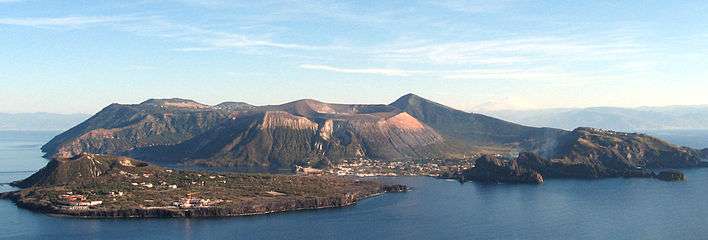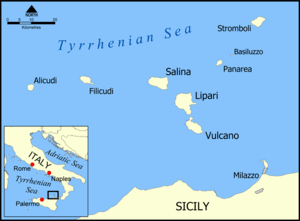Vulcano
| Vulcano | |
|---|---|
 | |
| Highest point | |
| Elevation | 501 m (1,644 ft) |
| Prominence | 501 m (1,644 ft) |
| Coordinates | 38°23′58″N 14°57′50″E / 38.399434°N 14.963955°ECoordinates: 38°23′58″N 14°57′50″E / 38.399434°N 14.963955°E |
| Geography | |
 Vulcano and the Aeolian Islands.
| |
| Location | Aeolian Islands, Italy |
| Geology | |
| Mountain type | Complex stratovolcanoes |
| Last eruption | 1888 to 1890 |
.jpg)
Vulcano (Sicilian: Vurcanu) is a small volcanic island in the Tyrrhenian Sea, about 25 km (16 mi) north of Sicily and located at the southernmost end of the eight Aeolian Islands. The island is 21 km2 (8 sq mi) in area, rises to 501 m (1,644 ft) above sea level, and it contains several volcanic caldera, including one of the four active volcanoes in Italy that are not submarine. The word "volcano" and its equivalent in several European languages derive from the name of this island, which in turn derives from Vulcan, the Roman god of fire.
History
The Romans used the island mainly for raw materials, harvesting timber, and mining alum and sulfur. These were the principal activities on the island until the end of the 19th Century.
After the Bourbon rule collapsed in 1860, a Briton named James Stevenson bought the northern part of the island, built a villa, reopened the local mines, and planted vineyards for making Malmsey wine. Stevenson lived on Vulcano until the last major eruption on the island happened in 1888. This eruption lasted the better part of two years, by which time Stevenson had sold all of his property to the local populace. He never returned to the island. His villa is still intact.
Geology

The volcanic activity in the region is largely the result of the northward-moving African Plate meeting the Eurasian Plate. There are three volcanic centres on the island:
- At the southern end of the island are old stratovolcano cones, Monte Aria (501 m (1,644 ft)), Monte Saraceno (481 m (1,578 ft)) and Monte Luccia (188 m (617 ft)), which have partially collapsed into the Il Piano Caldera.
- The most recently active centre is the Gran Cratere at the top of the Fossa cone, the cone having grown in the Lentia Caldera in the middle of the island, and has had at least nine major eruptions in the last 6000 years.
- At the north of the island is Vulcanello (123 m (404 ft)), connected to the rest of it by an isthmus which is flooded in bad weather. It emerged from the sea during an eruption in 183 BCE as a separate islet. Occasional eruptions from its three cones with both pyroclastic flow deposits and lavas occurred from then until 1550, with the last eruption creating a narrow isthmus connecting it to Vulcano.
Vulcano has been quiet since the eruption of the Fossa cone on 3 August 1888 to 1890, which deposited about 5 m (16 ft) of pyroclastic material on the summit. The style of eruption seen on the Fossa cone is called a Vulcanian eruption, being the explosive emission of pyroclastic fragments of viscous magmas caused by the high viscosity preventing gases from escaping easily. This eruption of Vulcano was carefully documented at the time by Giuseppe Mercalli. Mercalli described the eruptions as "...Explosions sounding like a cannon at irregular intervals..." As a result, vulcanian eruptions are based on this description. A typical vulcanian eruption can hurl blocks of solid material several hundreds of metres from the vent. Mercalli reported blocks from the 1888-1890 eruption fell in the sea between Vulcano and Lipari, several were photographed by him or his assistants that had fallen on the island of Vulcano.
Volcanic gas emissions from this volcano are measured by a multicomponent gas analyzer system, which detects degassing of rising magmas before an eruption, improving prediction of volcanic activity.[1]
A survey on local groundwater occurred during 1995-1997 showed temperatures up to 49-75°C, sodium sulfate-chloride chemical composition and near neutral pH in the water wells closest to the slopes of the volcanic cone. This is mainly due to condensation of to the slopes of the volcanic cone and water-rock interaction buffering.[2][3]

Biology
Since Vulcano island has volcanic activity, it is a place where thermophiles and hyperthermophiles are likely to be found. In fact, the hyperthermophilic archaea Pyrococcus furiosus was described for the first time when it was isolated from sediments of this island by Gerhard Fiala and Karl Stetter.[4]
Mythology
The Ancient Greeks named the island Therassía (Θηρασία) and Thérmessa (Θέρμεσσα, source of heat). The island appeared in their myths as the private foundry of the Olympian god Hephaestus, the patron of blacksmiths. He had another two foundries at Etna and Olympus. Strabo also mentions Thermessa as sacred place of Hephaestus (ἱερὰ Ἡφαίστου), but it is not clear if it was a third name for the island, or just an adjective.[5]
Similarly, the Romans believed that Vulcano was the chimney of the god Vulcan's workshop and therefore named the island after him. The island had grown due to his periodic clearing of cinders and ashes from his forge. The earthquakes that either preceded or accompanied the explosions of ash were considered to be due to Vulcan making weapons for the god Mars and his armies to wage war.[6]

Trivia
Between 1949 and 1950, the motion picture "Vulcano", which was directed by William Dieterle, was filmed on Vulcano and the nearby island of Salina. Starring Anna Magnani, Rossano Brazzi, and Geraldine Brooks of New York, the movie was produced by Panaria Film by Prince Francesco Alliata for release to theaters on 2 February 1950. The crew also participated in the ethos of the photographer Fosco Maraini. This film was also later dubbed into English and shown in the United States.
An asteroid is named for this island, 4464 Vulcano.[7]
The island of Vulcano is also present in Part 2 of JoJo's Bizarre Adventure by Hirohiko Araki and is the scene of the final clash between the protagonist Joseph Joestar and the antagonist Kars, leader of the Pillar Men.
In the opinion of the American attorney and writer Richard Paul Roe, the comedy play "The Tempest" by William Shakespeare is set on the island of Vulcano. [8]
See also
- List of volcanoes in Italy
- List of islands of Italy
- Vulcan (mythology)
- Vulcano a 1950 Italian drama film supposedly set on the island.
References
- ↑ "Chemical mapping of a fumarolic field: La Fossa Crater, Vulcano Island (Aeolian Islands, Italy)". Geophysical Research Letters. AGU Publications. 32. Bibcode:2005GeoRL..3213309A. doi:10.1029/2005GL023207. Retrieved 2016-09-27.
- ↑ Boschetti, Tiziano; Cortecci, Gianni; Bolognesi, Luca (2003). "Chemical and isotopic compositions of the shallow groundwater system of Vulcano Island, Aeolian Archipelago, Italy: an update". GeoActa. 2: 1–34.
- ↑ Cortecci, Gianni; Dinelli, Enrico; Bolognesi, Luca; Boschetti, Tiziano; Ferrara, Giorgio (2001). "Chemical and isotopic compositions of water and dissolved sulfate from shallow wells on Vulcano Island, Aeolian Archipelago, Italy". Geothermics. 30 (1): 69–91. doi:10.1016/s0375-6505(00)00037-7.
- ↑ Fiala, G., & Stetter, K. O. (1986). Pyrococcus furiosus sp. nov. represents a novel genus of marine heterotrophic archaebacteria growing optimally at 100 °C (212 °F). Archives of Microbiology, 145, 56–61.
- ↑ Strabo Geographica 1.2.10
- ↑ "CVO Menu - Volcanoes in Historical and Popular Culture". Vulcan.wr.usgs.gov. Retrieved 2013-08-26.
- ↑ M.P.C. 26762 del 5 marzo 1996
- ↑ Richard Paul Roe (2011). The Shakespeare Guide to Italy: Retracing the Bard's Unknown Travels. HarperCollins. p. 265-296. ISBN 978-0-06-207427-0.
Sources
- Ezio Giunta, dir. (2005). "Vulcano". Estateolie 2005*The Essential Guide (English version of Tourist Guidebook): 80–87.
- "Vulcano". Global Volcanism Program. Smithsonian Institution. Retrieved 2008-12-18.
External links
| Wikimedia Commons has media related to Vulcano (Isola). |
| Wikivoyage has a travel guide for Vulcano. |
